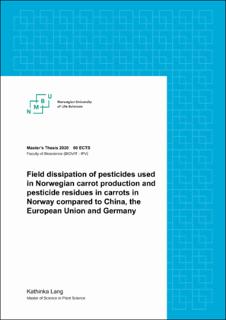| dc.description.abstract | The use of pesticides has not only positive effects on yield and food safety but also poses a risk to the environment and human health. Residues of pesticides are frequently detected in food crops, water, and soil, but a lack of knowledge regarding field dissipation and residues in soil under current agricultural practices was identified by Silva et al., (2019).
The aim of this study was to assess the status of pesticide residues in carrots and their dissipation in soils from carrot production in Norway under current agricultural practices and to compare it to available data from the EU, Germany, and China. To achieve this, data on pesticide residues in carrots from Norway, the EU, Germany, and China was compiled and compared. To determine the dissipation of pesticides in soil under current agricultural practices a field study was conducted on two carrot fields in southeast Norway. Soil samples were taken from May 2019 – April 2020 and extracted with acetonitrile. Dissipation rates were modelled and compared to existing data.
From the literature study it was found that most pesticides detected in carrots in the EU are fungicides. In all three regions investigated (Norway, the EU, Germany) boscalid was the most detected pesticide in carrots. When pesticide residues in Europe were compared to China, it was found that many pesticides used in China are banned in the EU. Unlike in the EU, mainly insecticides were detected in China. In all regions, residues of non-approved and sometimes long banned pesticides were found in carrots and vegetables.
In the field study, boscalid, cyprodinil, fludioxonil, metribuzin, and pyraclostrobin were sprayed in 2019 and detected in the soil samples. Additionally, several background pesticides were detected, of which some had been sprayed prior to 2016, indicating long persistence in soils with calculated half-lives of over 1000 years. Of all pesticides detected in the soil, most were fungicides. For pesticides that had been sprayed in 2019, metribuzin and pyraclostrobin showed similar half-lives to those reported in the EU. For boscalid the half-life was found to be shorter, probably as a result of uptake into carrots and potentially leaching events during winter. Cyprodinil and fludioxonil were found to have a longer persistence in soils than previously reported, which was concluded to be a result of cold climate conditions due to application late in the season, or lower amounts taken up by plants. | en_US |

